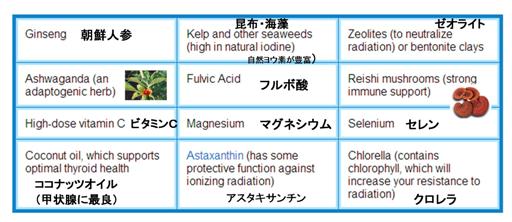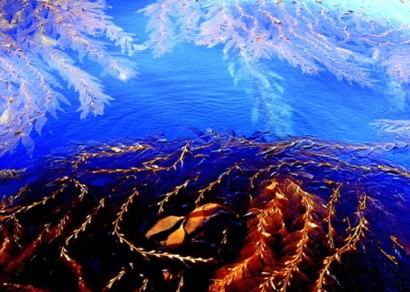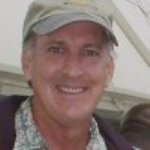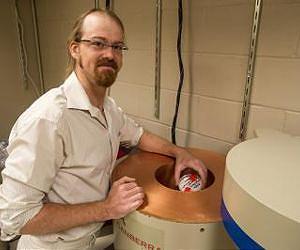アメリカの主要メディアが報じない食に関するオンラインニュースを提供している

より。
Radiation from Fukushima
福島からの放射能
Editor's note: The most effective supplements to prevent damage induced by radiation may be vitamin C, according to a Japanese study. Fukushima nuclear disaster is not the only thing Americans need to be worried about. As many as 14 states have been polluted by the nuclear tests conducted in the U.S. in 50's, according to some reports. The clean states are only those in the West like Oregon, California, and maybe Washington as well.
編集メモ:
日本の研究によると、放射能により引き起こされる損傷を防ぐ最も効果的なサプルメントは、おそらく
ビタミンCだろうとのこと。福島の惨事は、アメリカ人が懸念すべき唯一のことではありません。いくつかの報告によると、14の州が50年代に行われた核実験で汚染されています。きれいな州は、オレゴン、カリフォルニア、おそらくワシントン州だけかもしれません。
By Dr. Mercola
On March 11, 2011, a powerful earthquake and tsunami rocked Japan, and fatally crippled TEPCO's Fukushima nuclear power plant.
2011年3月11日に、強力な地震と津波が日本を揺さぶり、東電の福島原子力発電所を致命的に麻痺させました。
Exactly how much radiation has poured out, contaminating not only cleanup crews but also residents in surrounding areas, remains unclear, as does the risk posed to the rest of the world from nuclear fallout.
正確に放射能がどのくらい噴出したのか、除染作業員たちだけでなく、周辺地域の住民がどれだけ被曝したのかは、未だに不明です。放射能の降下物で、日本以外の世界がどれだけ危険に曝されているのかも不明です。
One thing is clear: this disaster is far from over… and emerging evidence suggests the impacts may be far worse than we are being led to believe.
1つだけ明らかのことがあります。この惨事が収束からは程遠いということです。そして、浮かび上がってくる証拠は、その影響が、わたしたちが信じ込まされてきたことよりはるかに悪いかもしれないことを示唆しています。
[Radiation Levels at Fukushima Now at Record Highs]
福島の放射能レベルは今では最高記録
It's been over 1 year since the damage occurred, but it's just now being reported that samples from the basement of reactor number 1 revealed radiation levels that reached up to 10,300 millisievert (mSv) an hour, which is enough to make a person sick within minutes, and kill them shortly thereafter. To put this in perspective, the workers at this site reach their annual allowed radiation dose in 20 seconds.1
損傷が起こってから1年以上が立っていますが、1号機の地下のサンプルの放射能レベルが、毎時10,300ミリシーベルトまで達していたことが明らかになりました。それは、人間が数分で病気になり、その後すぐに死んでしまうというレベルです。それを考えると、現場の作業員は、20秒で年間許容被曝量に達してしまうことになります。
Needless to say, workers cannot go anywhere near the site, so robots must be used, and it's estimated that complete demolition of the plant will take four decades and require new cleanup technologies to be completed.
言うまでもなく、作業員は、現場近くのどこへも行けません。ロボットを使わなければならず、原発の取り壊しを終えるのに40年かかると推測され、新しい除染技術が必要となるでしょう。
Adding to the already precarious situation, another of the reactor buildings –
which houses 1,331 spent and 204 unused nuclear fuel assemblies, each of which contains approximately 50-70 nuclear rods – is now tilting and the walls are bulging outward. If another earthquake occurs or the building collapses, large amounts of radiation could be released into the environment.
既に当てにならない状況に加え、もう一つの原子炉建屋は-1331本の使用済み燃料、204本のまだ使用していない核燃料集合体が収められいて、それぞれに約50-70の核燃料棒が収容されています。それが傾き、壁が外に膨らんでいます。もし地震が起こったり、建物が崩壊すれば、大量の放射能が環境に放出されるのです。
Obviously, the situation is still incredibly volatile, so it is a mystery why the U.S. Environmental Protection Agency (EPA) only conducted accelerated sampling from March to June 2011. When their tests reportedly showed that the radiation levels remained "well below any level of public health concern and were consistently declining,"
they switched back to their routine radiation monitoring.
明らかに、状況は信じがたいほどに不安定です。なぜアメリカの環境保護庁がサンプリングを加速させたのが、2011年の3月から6月だけだったのかが謎です。報告によれば、彼らの検査は、その放射能レベルが「公衆の健康に心配なレベルより十分低く、常に減少している」と示しました。そして、通常の放射能モニタリングに切り替えたのです。
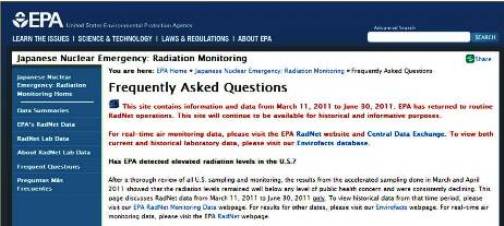
But according to a
report from the Congressional Research Service, radiation-contaminated debris from Japan may take up to three years before it reaches the U.S. West Coast:4
しかし、議会のリサーチサービスからの報告によると、放射能で汚染された日本からの瓦礫がアメリカの西海岸に到着するのは、あと3年ほどだろうとのことです。
"Based on computer modeling of ocean currents, debris from the tsunami produced by the Tohoku earthquake was projected to spread eastward from Japan in the North Pacific Subtropical Gyre. Approximately two to three years after the event, the debris plume likely will reach the U.S. West Coast, dumping debris on California beaches and the beaches of British Columbia, Alaska, and Baja California.
「コンピューターの海流モデルによると、東北地震が生み出した津波からの瓦礫は、日本から東へ、北太平洋亜熱帯旋廻へ広がると予測されています。災害から約2~3年で、瓦礫の島は、アメリカ西海岸に到達し、カリフォルニアとBC、アラスカ、バハ・カリフォルニアの海岸に打ち寄せるでしょう。
Although much of the radioactive release from Fukushima Dai-ichi is believed to have occurred after the tsunami, there is the possibility that some of the tsunami debris might also be contaminated with radiation."
福島第一からの放出された多くの放射性物質は津波の後に発生したと考えられていますが、
津波瓦礫のいくらかが放射能で汚染されている可能性もあります。」
They point out that although the ocean currents have a slow flow, there is still a threat posed because radioactive contaminants are incredibly persistent in the environment:
彼らは、海流の流れがゆっくりしているけれど、
放射能汚染は環境中において信じがたいほどに執拗であるため、その危険がまだあるのだと指摘します。
"Although these currents have the potential for bringing radiation from Japan's Fukushima Dai- ichi nuclear accident to U.S. waters, their flow is slow, and no radiation above background levels has yet been detected in marine waters under U.S. jurisdiction. Regardless of the slow flow, radioactive contaminants with long half-lives (e.g., cesium-137, with a half-life of about 30 years) could still pose concerns if transported over long distances by ocean currents."
「これらの海流は、日本の福島第一原発事故から、放射能をアメリカの海水へ運んでくる可能性がありますが、その流れはゆっくりであり、米国管轄地域の海水からバックグランドよりも高い放射能はまだ検出されていません。流れがゆっくりであるにしろ、半減期の長いもの(例えば、セシウム137は半減期が約30年)は、海流により長距離を移動してくるという懸念が残っているのです。」
Strangely, in the report they make mention of managing arriving debris in order to return items of potential personal, symbolic and cultural value, but do not discuss the radiation implications…
奇妙なことに、その報告で、私物である可能性のあるもの、象徴的、文化的価値のあるものを返却するために、流れ着いた瓦礫を管理することに言及していますが、放射能については触れていません。
Case in point,
15 bluefin tuna caught near San Diego, California in August 2011 were found to contain Fukushima-derived radiation, including caesium-137 and caesium-134, at levels 10 times higher than those detected in previous years. The researchers noted:5
その適例は、カリフォルニア州サンディエゴ近くで2011年8月に獲れたクロマグロ15匹に、福島由来の放射能を含んでいることが発見されたことです。セシウム137と134を含み、前年の10倍の放射能レベルを検出しました。研究員は次のように述べています。
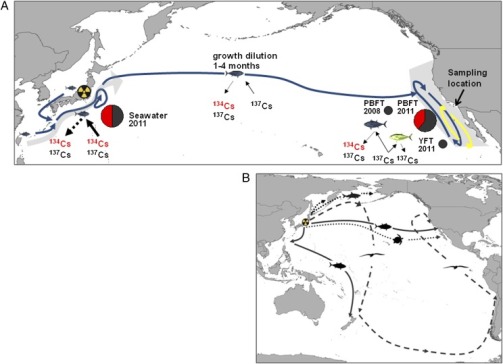
"These findings indicate that Pacific bluefin tuna can rapidly transport radionuclides from a point source in Japan to distant ecoregions and demonstrate the importance of migratory animals as transport vectors of radionuclides. Other large, highly migratory marine animals make extensive use of waters around Japan, and these animals may also be transport vectors of Fukushima-derived radionuclides to distant regions of the North and South Pacific Oceans."
「これらの発見は、太平洋のクロマグロが日本の漏洩発生源地点から遠く離れた生態海域へ、放射性核種を迅速に運んだことを示唆し、
放射性核種の媒体としての回遊動物の重要性を論証しました。他の、回遊する大きな海洋動物は、日本周辺の水を広範囲に渡り利用し、
福島由来の放射性核種を北太平洋、南太平洋の遠くの地域まで運ぶ媒体となるかもしれないのです。
Is Fukushima Worse Than Chernobyl?
福島はチェルノブイリよりも深刻?
When the Chernobyl reactor melted down in 1986, approximately 134 plant workers and firefighters were exposed to high doses of radiation – 800 to 16,000 mSv – and developed acute radiation sickness. Of those 134 workers, 28 died within 3 months of exposure.
1986年にチェルノブイリの原子炉がメルトダウンしたとき、約134名の原発作業員と消防士たちが高線量の放射線に被曝しました。-800~16,000ミリシーベルトです-そして、急性被曝症を発病しました。これらの134名の作業員たちのうち28名が被曝から3ヶ月以内に死亡しました。
In total, more than 160,000 children and 146,000 cleanup workers became victims of radiation poisoning as a result of living and working in that radiotoxic environment, raising the incidence of birth defects, leukemia, anemia, cancers, thyroid disease, liver and bone marrow degeneration, and overall severely compromised immune systems.
合計、16万人の子供たちと、14万6000人の除染作業員が、放射能の毒の環境下に暮らし、働いた結果としてその犠牲となり、先天性異常、白血病、貧血症、癌、甲状腺疾病、肝臓・骨髄変質のケースが増え、全体的に免疫システムを深刻に傷つけました。
These, however, are only estimates, and according to some data,
Chernobyl deaths may actually top 1 million. Fukushima is the largest nuclear disaster since, but there are many similarities popping up. For one, as the Institute of Science in Society (ISIS) points out:7
しかしながら、これらは推測に過ぎず、いくつかのデータによると、チェルノブイリからの死は、実際には百万人を上回るかもしれないとしています。福島はそれ以来の最大のものですが、多くの類似点が浮かび上がっています。その1つを、科学研究協会(ISIS)が指摘しています。

"From the beginning, the official nuclear safety experts were at pains to minimize the projected health impacts, as they are doing now for the Fukushima accident."
「最初から、原子力安全専門家たちは、予測される健康被害を必死に過小評価していました。今は、福島事故で同じことをしています。」
According to ISIS, with Chernobyl, they underestimated related deaths by:
ISISによると、チェルノブイリでは、被曝に関連のある死亡ケースを以下のように過小評価しました。
•Underestimating the level of radiation by averaging exposure over a large region, such as an entire country, so high exposure doses and health statistics of the most contaminated areas are lumped together with the less and least exposed
国全体のような広範囲の地域を通しての平均被曝により、放射線レベルを過小評価した。故に高線量、最も汚染されている地域と健康状態の統計が、より低いところと、最も低い被曝量と所と一緒にされた。
•Ignoring internal sources of radiation due to inhalation and ingestion of radioactive material from fallout
放射性物質の吸入、摂取による内部被曝を無視した。
•Using an obsolete and erroneous model of linear energy transfer due to external sources of ionizing radiation
放射線の外部被曝について、エネルギー伝達直線の、時代遅れで誤ったモデルを使用した。
•Not counting diseases and conditions other than cancers
癌以外の疾病や症状を数に入れなかった。
•Overestimating the natural background radiation; today's "background" has been greatly increased by discharges from nuclear activities including tests of nuclear weapons, use of depleted uranium, and uranium mining
自然放射線を過大評価した。今日のバックグンド線量は、核兵器実験、原子力活動、不完全なウラン使用、ウラン発掘を含む原子力活動からの放出により、大幅に上昇している。
•Suppressing and withholding information from the public
情報の抑圧と自制。
Writing in
Forbes, Jeff McMahon also pointed out what appear to be strategies to minimize public perceptions of the real risks of the Fukushima radiation:
ジェフ・McMahonが、Forbes紙の中で、福島の放射能の本来の危険についての人々の視野を最小限にするための戦略で何が明らかなのかを指摘しました。
"Covering the story, I watched the government pursue what appeared to be two strategies to minimize public alarm:
「隠蔽。わたしは、人々の警戒心を最小限にするために政府が突き進んでいる2つの戦略が露わになったのを見た。
•It framed the data with reassurances like this oft-repeated sentence from the EPA: 'The level detected is far below a level of public health concern.' The question, of course, is whose concern.
頻繁に繰り返されるEPAの言葉のように、人々を安心させるデータを工夫する。「検出されたレベルは、健康に対して懸念されるレベルよりはるかに低いものです。」もちろん、問題は、誰の懸念か、ということである。
•The EPA seemed to be timing its data releases to avoid media coverage. It released its most alarming data set late on a Friday – data that showed radioactive fallout in the drinking water of more than a dozen U.S. cities."
EPAはメディアで流すデータのタイミングをはかっていた。最も警戒を要するデータは、金曜日の夜遅くに流した。アメリカの12以上の都市での飲料水への放射性降下物を示すようなデータのこと。」

And again, while downplaying the risks of contaminated U.S. seafood, the
Congressional Research Service goes into great detail on the magnitude of radiation that entered the ocean water following the disaster:
そしてまた、アメリカの海産物の危険性について、問題を小さく見せようとする中、議会のリサーチサービスは、災害に続いて海に入り込んだ放射能の規模について、かなり詳細に渡り追求しました。
"Seawater was monitored by the Tokyo Electric Power Company (TEPCO) near the discharge points of the Fukushima Dai-ichi plant following the March 2011 events. Water with a dose rate of greater than 1,000 millisievert per hour was confirmed by TEPCO on April 2, 2011, in a pit located next to Fukushima Dai-ichi's Unit 2 seawater inlet point.
「2011年の事故の後、福島第一原発の放射能放出地点近くの海水は、東電によりモニタリングされていました。その量は、入り江地点の2号機の隣に位置するクボミ内の海水で、毎時1000ミリシーベルト以上だと、2011年4月2日に東電により確認されました。
A cracked sidewall of this pit was leaking water from the pit directly into the ocean. Analyses of seawater taken from near the discharge from Fukushima Dai-ichi Units 1-4 yielded readings of 130,000 Becquerels/liter (Bq/l) of iodine-131 (half-life of about 8 days), 32,000 Bq/l of cesium-137 (half-life of about 30 years), and 31,000 Bq/l of cesium-134 (half-life of about 2 years).
このクボミの割れた側壁から、漏洩した水が直接海に流れ込んでいます。福島第一1号機~4号機からの放出されている付近で採った海水の分析から、1リットル(1kg)あたり13万ベクレルのヨウ素(半減期約8日)、3万2000ベクレルのセシウム137(半減期約30年)、そして3万1000ベクレルのセシウム134(半減期約2年)が測定されました。
…Experts cite this incident as the largest recorded accidental release of radiation to the ocean.
専門家は、この事象が、海に放出された放射能の最大の記録としています。
…It is unknown whether marine organisms that migrate through or near Japanese waters to locations where they might subsequently be harvested by U.S. fishermen (possibly some albacore tuna or salmon in the North Pacific) might have been exposed to radiation in or near Japanese waters, or might have consumed prey that had accumulated radioactive contaminants."
日本の海の近くを回遊する海洋生物が、後にアメリカの海域で、漁師により収穫され(可能性のあるのは、北太平洋のビンショウマグロや鮭)、日本の海やその近くで被曝したかもしれない、あるいは、放射能汚染が蓄積された餌食を食べたかもしれないかどうかについては、知られていません。
Did 14,000 Americans Already Die from Fukushima Radiation?
1万4000人のアメリカ人が既に福島の放射能が原因で死亡した?
Meanwhile, a
report published in the International Journal of Health Services suggests that up to 14,000 deaths related to Fukushima may have already occurred in the United States:
一方、ヘルスサービスインターナショナル誌に掲載された報告では、米国での1万4000人の死が、福島に関係している可能性があると発表しました。
"Deaths rose 4.46 percent from 2010 to 2011 in the 14 weeks after the arrival of Japanese fallout, compared with a 2.34 percent increase in the prior 14 weeks. The number of infant deaths after Fukushima rose 1.80 percent, compared with a previous 8.37 percent decrease. Projecting these figures for the entire United States yields 13,983 total deaths and 822 infant deaths in excess of the expected.
「2010年から2011年の死亡が、日本の降下物が到着した後の14週前で2.34%だったのに比べ、降下物到着後の14週間ではで4.46%増えました。福島の事故の後の幼児の死亡は、事故前に8.37%減少していたのに比べ、1.8%上昇しました。これらの数字から算出すると、米国では、1万3,987名の死と822人の幼児の死が推定より多かったことになります。
…Recent assessments have suggested that the amount of radioactivity released from Fukushima equals or exceeds that released from Chernobyl. Given the continuing emission of radioisotopes from the melted reactors, the high density of population around the plant, and the close proximity to food sources, we can expect that morbidity and mortality will be high in Japan.
最近の査定では、福島からの放射性核種の放出量は、チェルノブイリからのものと同じか、それ以上であるとされています。溶けた原子炉からの放射性同位体の絶え間ない排出、発電所周辺の人口密度の高さと、近辺からの食物のことを考えれば、発病率や死亡率が日本で高くなることは予想されうることです。
…Adverse health effects may also be expected in the United States, even though exposures have been far below those in Japan. Low-dose radiation exposure, previously assumed to be harmless, has been linked with elevated disease rates in children born to women who underwent pelvic X-rays while pregnant, Americans exposed to atomic bomb fallout, nuclear plant workers, and, for leukemia, children exposed to very low doses after Chernobyl. In addition to physical diseases is loss of cognitive ability in adolescents following low-dose ionizing radiation in utero."
日本に比べれば被曝量ははるかに低いですが、米国でも健康被害の影響が予測されています。以前は無害だと思われていた低線量被曝と、妊娠中に骨盤にレントゲンを受けた女性に生まれてきた子どもたち、原爆降下物に被曝したアメリカ人、原発作業員たちの高い疾病率とが関連付けられ、チェルノブイリの事故後に低線量被曝した子どもたちと、高い白血病疾病率が関連付けられました。
 The Potential Dangers of Low-Dose Radiation
The Potential Dangers of Low-Dose Radiation
低レベル放射能に考えられる危険性
If the levels of radiation that reach the U.S. are, in fact, low, this may still pose a formidable threat to human health and the environment. In 2010, the
United National Scientific Committee released a report on the effects of low-dose radiation, noting the following (the report uses the term 'low dose' to mean doses of radiation below 200 mGy – a computed tomography (CT) scan delivers about 10 mGy):
アメリカに到達した放射能のレベルが、実際に低いとしても、人間の健康と環境に恐るべき脅威を曝しているかもしれないのです。2010年に国連科学委員会が低線量の放射線の効果についての報告を発表しました。以下に記します。(文中の「低線量」とは200mGy以下を意味します。CTスキャンは約10mGyです。)
**Measured Dose (Temporary Measurements) – gamma radiation or X-rays
1 R (roentgen) = 0.01 Gy = 0.01 Sv
•There is strong evidence of "statistically significant" elevations of risk of solid tumors and leukemia above doses of 100 – 200 milligray (mGy)
100-200mGy以上の線量で、固形腫瘍、白血病の高い危険性を示す統計学的に有意である強力な証拠がある。
•Findings of elevated incidence of circulatory disease in populations irradiated at high doses are raising some concern
高線量に放射能汚染されている住民における循環系疾患の高い発生率が見出されたことは、懸念を起こすものである。
•There is "increasing evidence" of radiation exposure leading to increased incidence of cataracts
放射線被曝から、白内障の事例が増えている証拠がある。
•Radiation exposure of the developing embryo or fetus during pregnancy can also contribute to the appearance of non-cancer diseases in children. In addition to the induction of congenital mal-formations, the central nervous system is particularly affected … Mainly on the basis of animal studies and some observations following high-dose exposures of pregnant women, the Committee considers that there is a threshold for these effects at about 100 mGy.
妊娠中に発育中の胚胎や胎児が被曝した場合も、子どもに癌性ではない疾病が現れる。先天的危険の誘発に加え、中枢神経系が特に影響を受ける。主に、動物の研究と、高線量を被曝した妊婦を観察したことに基づいて、委員会は100mGyにおいてこれらの影響のしきい値があるのだと考える。
•There is emerging evidence from recent epidemiological studies indicating elevated risks of non- cancer diseases below doses of 1 to 2 Gy, and in some cases much lower.
最近の疫学的研究から浮かび上がってきた証拠は、1から2Gy以下の癌以外の疾病の危険が高まったことを示した。いくつかのケースでは、ずっと低かった。
**1Gyは1000mGy。1000-2000mGyつまり1000-2000mSv。。。
Although this report was released in 2010,
scientists are just now going to review it to help assess the true effects of Fukushima. There is also a phenomenon known as the "bystander effect," which multiplies the dose and harm from radiation exposures. According to Dr. Mae-Wan Ho, cells that have not been exposed to radiation can be harmed by nearby cells that have. Writing for ISIS, Dr. Ho explains:14
この報告は2010年に発表されたのですが、科学者たちは今、それを福島の影響を査定するのに役立てるため、見直そうとしています。また、被曝量が何倍にもなり、有害である「バイスタンダー効果」として知られている現象があります。Mae-Wan Ho医師によると、放射線に曝されなかった細胞が、被曝した近くの細胞によって傷つけられるのだ、ということです。
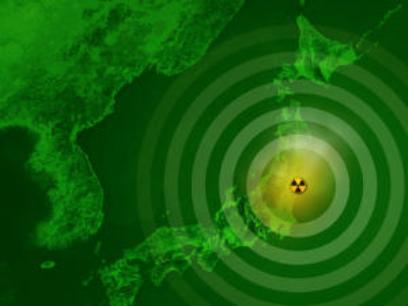
"…low dose radiation is all the more dangerous because it does not kill the targeted cell, but allows its influence to spread widely to adjacent cells, thus multiplying the radiation effect (about 100 fold) …a wide range of bystander effects in cells not directly exposed to ionizing radiation have been found, which are the same as or similar to those in the cells that were exposed, including cell death and chromosomal instability."
「
低線量被曝は、かえって危険なのです。ねらった細胞を破壊するのではなく、周りの細胞に幅広く広がり影響を与えることになるからです。このように何倍もの影響(約100倍)となり、直接放射線被曝していない細胞の広い範囲でバイスタンダード効果が見つかると、細胞が死んだり、染色体切断を含み、放射線被曝した細胞と同じか類似しているということになります。」
Currently, there is a considerable push to understand bystander effects, genomic instability, and adaptive response after radiation exposure in low doses… but
it is now clear that bystander effects do occur and are a general phenomenon induced by all types of radiation.
現在、バイスタンダート効果、ゲノム不安定性、低被曝後の適応反応について理解する強い動きがありますが、今明らかなのは、バイスタンダード効果が起こり、それが、全てのタイプの放射線に誘発される一般的現象だということです。
What Can You do to Minimize Your Risks of Radiation Exposure?
放射能被曝の危険性を最小限にするために何ができるのか?
First and foremost, if you live in an area with elevated levels in drinking water, be sure you either find an alternative source of water – such as your nearest natural spring16 – or filter it with a high-quality filter. When it comes to radiation, reverse osmosis is effective at removing most particles from your water.
最初に、真っ先にできることは、高レベルに汚染されている飲料水のある地域に住んでいるのであれば、他の水を確保する、一番近いところにある自然の泉、あるいは高性能のフィルターを通した水のようなものです。放射能ということになると、逆浸透圧法が、水からほとんどの粒子を除去するのに有効です。
If you're looking for strategies to help prevent damage caused by radiation exposure, researchers noted in the
International Journal of Low Radiation that the most active molecular form of vitamin D – D3 (also known as calcitriol) – may offer protection against a variety of radiation-induced damages, including even those caused by background radiation or a low-level nuclear incident.
被曝からの被害を防ぐ戦略を探しているのであれば、低線量インターナショナルジャーナルで研究者が示しているように、
ビタミンDの最も活発な分子であるD3(カルシトリオール としても知られてる)が放射線が誘発する様々な健康被害に対して防護してくれるであろう、ということです。バックグランドの放射線や、低レベルの原子力事故によるものも含まれます。
The protective mechanisms are so strong that researchers suggested vitamin D3 should be considered among the prime (if not the primary) non-pharmacological agents to protect against sub-lethal low radiation damage and, particularly, radiation-induced cancer.
防護メカニズムがとても強いので、研究者たちは、低線量の放射線の致死以下の健康被害、特に放射線が誘発する癌から防護するために、のビタミンD3が主要な、(そうでないにしても)非薬理的医薬品として考えられるべきだ、と主張しています。
Spirulina
スピルリナ
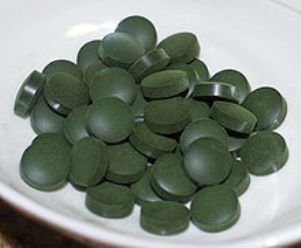
Spirulina – a blue-green algae – might be another useful alternative to protect against the effects of radiation. Spirulina was actually used to treat children exposed to chronic low levels of radiation after the Chernobyl nuclear disaster.
青緑の藻類で、放射能の影響に対して防護するのに有効なもう一つの選択肢でしょう。スピルリナは、チェルノブイリ事故の後、低線量の放射線に慢性的に被曝している子どもたちの治療に使われました。
According to a scientific review of spirulina's benefits:18
科学者のスピルリナ効果の見直しによると、
"Up to very recently, the interest in Spirulina was mainly in its nutritive value. Currently, however, numerous people are looking into the possible therapeutic effects of Spirulina. Many pre-clinical studies and a few clinical studies suggest several therapeutic effects ranging from reduction of cholesterol and cancer to enhancing the immune system, increasing intestinal lactobacilli, reducing nephrotoxicity by heavy metals and drugs and radiation protection."
「ごく最近まで、スピルリナへの関心は主にその栄養価値にありました。しかし、最近になって、多くの人たちがスピルリナの治療的効果の可能性について調べています。多くの前臨床研究やいくつかの臨床研究は、コルステロールと癌を減少させ、免疫システムを高め、腸の乳酸菌を増やし、重金属やドラッグ、放射線防護による腎毒性を減少させる効果を提言しています。」
But what is it about this blue-green algae that gives it this radiation-protective capacity? Spirulina has a 16 percent phycocyanin content – a blue pigment that is attached to its photosynthetic membranes. Phycocyanin is also a nitrogen storage molecule. The nitrogen atoms can form a complex with heavy metals such as radioactive cesium and stronium, hence "cleansing" these radioactive metals from your body.
しかし、この青緑の藻が放射能防護の力を与えるというのは、どういうことなのでしょう?スピルリナは、16%の藍藻素(フィコシアニン )を含んでいます。それに付着している青い色素が光合成膜に付着しているのです。藍藻素はまた、窒素保管分子でもあります。窒素原子は、放射性セシウムやストロンチウムのような重金属と複合体を形作り、要するに、これらの放射性重金属をあなたの体から「洗浄」するのです。
Turmeric
ウコン

Turmeric contains a broad spectrum of water, fat and alcohol-soluble components, all of which may contribute to reducing damage associated with both external radiation and internalized radioisotope exposures. It accomplishes this primarily through reducing oxidative stress to cellular structures, particularly DNA.
ウコンは水の幅広いスペクトラムを含んでいる、太い、アルコールに溶ける構成要素です。それら全てが、外部被曝、内部被曝両方に付随する被害を減少させることに役立つでしょう。主に細胞構造、特にDNAに対する酸化ストレスを減少させることで効果を産みます。
Research demonstrates that it has significant radioprotective properties, and of particular importance in selecting a turmeric product is that it be certified organic to ensure it has not been gamma irradiated (ironic?) with radioactive cobalt-60 in the USDA-approved process known as "cold pasteurization." Conventional spices are commonly exposed to as high as 30 Kilograys of gamma radiation, or the equivalent of 990 million chest x-rays worth of radiation. The irradiation of herbs produces formic acid, formaldehyde and unique radiolytic byproducts with carcinogenic properties.
調査から、ウコンが著しい放射線防護の特性を持ち、特にウコンを選ぶときに重要なのは、
低温殺菌」として知られる、USDAが認可しているプロセスで、放射性コバルト60と共に、ガンマ放射線を含んでいないもの〈皮肉ですね?)を確保するために、オーガニックと証明されているものでなければならないということです。因習的なスパイスは、一般的に30キログレイ、あるいは、9億9900万の胸部レントゲンに値するのガンマ放射線を発しています。ハーブの照射は、蟻酸、ホルムアルデヒド、発癌の特性を持つ放射性副産物を生み出します。
Whey
乳清
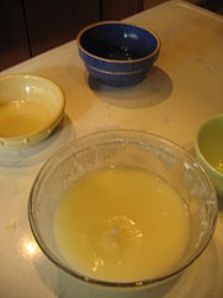
I interviewed Ori Hofmekler for an alternative viewpoint with regard to how you can decrease the risk to your health from radiation. Ori makes some compelling arguments for the use of a high-quality whey protein concentrate to help protect against absorbing radioactive minerals.
放射能から健康への危険を減らすのにどうすればよいのか、ということについての他の見解を聞くため、Ori Hofmeklerにインタビューしました。 Oriは、高品質の乳清の濃縮液を使用が、放射性ミネラル吸収することから防護するのに役立つのだと、説得力のある議論をします。
One of the reasons for using sweet whey is because whey protein contains all the precursors that help your body produce glutathione, which is one of the best ways to detoxify these toxins. The other reason is it's the highest source of all minerals and trace minerals that exist in nature. It has every possible mineral and trace elements – including organic sodium – that your body needs in the most bioactive form.
甘い乳清を使用する1つの理由は、乳清淡白が、体内でグルタチオンを生成するのを助けるすべての前駆物質を含んでいるからです。グルタチオンは、これらの毒素を解毒する、最良の方法の一つです。 もう一つの理由は、全てのミネラルと自然界に存在する微量金属-オーガニックナトリウムを含む- を最も多く摂れるからです。
Other Herbs and Supplements
その他のハーブとサプルメント
In general, the following foods, herbs and supplements may also help support your overall health in the event of radiation exposure:
一般的に、以下の食物、ハーブ、サプルメントは、放射線被曝時の健康全般にもよいとされています。
